
Home - Search - Browse - Alphabetic Index: 0- 1- 2- 3- 4- 5- 6- 7- 8- 9
A- B- C- D- E- F- G- H- I- J- K- L- M- N- O- P- Q- R- S- T- U- V- W- X- Y- Z
A-4b
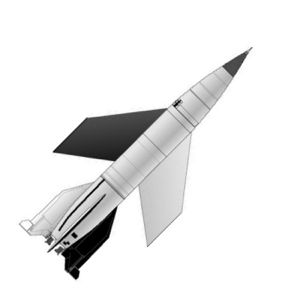 A4B Credit: © Mark Wade |
AKA: A4b;A9. Status: Retired 1945. First Launch: 1944-12-27. Last Launch: 1945-01-24. Number: 2 . Thrust: 312.00 kN (70,140 lbf). Gross mass: 14,150 kg (31,190 lb). Unfuelled mass: 5,360 kg (11,810 lb). Height: 13.60 m (44.60 ft). Diameter: 1.65 m (5.41 ft). Apogee: 85 km (52 mi).
Development of a winged version of the A4 began with work in the Peenemunde wind tunnel in November 1939. The tunnel was used an average of 500 hours per month. 1000 cubic meters of vacuum vessels were pumped to a 98% vacuum in three to five minutes by three banks of double vacuum pumps. When vented, they provided the tunnel with 20 seconds of run time at velocities from Mach 1.2 to Mach 4.0, or 1500 m/s. Models 4 to 5 cm in diameter x 30-40 cm long could be accommodated in the tunnel, instrumented at 110 data points. These tests showed that drag increased 70% at the sound barrier and that the center of pressure on the missile moved back one-half caliber. The wind tunnel runs showed that the basic A4 shape was all right, but that it needed load-carrying wings and a new rudder for the higher-speed A9 glider version. Three versions of the A9 were contemplated: as an extended-range boost-glide missile; as a manned supersonic aircraft; and as the upper stage of manned intercontinental and orbital spacecraft.
Huge trial and error was required to develop an A9 configuration that was stable, but not so stable that the control surfaces were too large. An arrow wing was the best performing, but the control surfaces were then in the turbulent flow of the wing and inadequate. Swept wings provided 12% less glide ratio than the arrow wing, resulting in a 60 km loss of range. Trapezoidal wings were the final solution for the use of, the end of a long iterative process. The original second stage A9 design was a refined A4 with swept wings. A later version had two fuselage strakes instead of wings. Wind tunnel tests showed that these provided better supersonic lift and solved the problem of transonic shift of center of lift. A secondary benefit was better packaging of the A9 into the forward interstage of the A10 in the upper-stage applications.
By adding wings to the A4, the 800 m/s of kinetic energy the rocket had at cut-off could be exploited in a glide attack, extending the range of the missile from 250 km to 550 km. Such a supersonic aircraft had never been flown and presented many aerodynamic and engineering problems in 1943. Various tests of A7 subscale models with wings began in early 1940. These were successful, and the full-scale configuration was dubbed the A9. The trajectory for such a missile involved a boost to an apogee of 29 km, then a stable glide at 20 km altitude at a speed of 1250 m/s. At the end of the glide, the missile would have descended to 5 km altitude, then make a vertical dive on the target in the fashion of the Fi-103/V-1. The A9 would be equipped with wings with a total area of 13.5 sq m. A manned version of this boost-glide rocketplane was also designed. This could reach a conventional airfield 600 km from the launch point in only 17 minutes, landing at a speed of 160 kph. Another possibility to further extend range would be a catapult-launched A9, using the technology developed for the V-1. This would provide an extra velocity of 350 m/s, further extending the missile's potential range.
Further refinement of the A9 design was halted in 1943 when von Braun's team was directed to devote itself completely to getting the V-2 into production. Von Braun managed to keep some detailed design work going 'under the radar' by designating the A9 the A4b, a classified modification of the A4.
In the fall of 1944, with the V-2 batteries being pushed back by allied advances beyond range of Britain, SS General Kammler ordered a crash program to complete the A9 and even the A9/A10. Von Braun was able to complete 10 A4b airframes by 24 October 1944, but component and propellant shortages delayed flight test.
The first launch attempt came on 27 December 1944. The steering failed at 30 m altitude, and the missile crashed a short distance from the pad. Several more test articles were on hand, but testing could not resume immediately due to a shortage of alcohol fuel. By this time 270 staff at Peenemuende were working on the A4b, but supply chain chaos was holding them back. The second and final launch attempt was on 24 January 1945. This reached 80 km altitude and 1200 m/s. It then flew stably in supersonic flight using its 13.5 square meter wing. The automatic guidance system was designed to keep the missile on course in both supersonic and subsonic flight regimes. However, the wing broke off shortly after the beginning of the glide. This concluded work on the A4b/A9; the increasingly chaotic situation in Germany prevented further flight tests.
Long after the war a mythology developed that in deep secret the A9/A10 reached flight status and that the 24 January test was a manned ICBM that was to attack New York. In this mythology Otto Skorzeny had been training a cadre of 100 astronauts to fly the A9. One of these, 'Rudolf Magnus Schroeder' was aboard the January launch. Schroeder became the first man in space, before biting into his cyanide capsule when the spacecraft burst into flames and crashed into the North Atlantic. There is no evidence that any of this is true.
Family: Boost-glide, Manned V-2's. People: von Braun. Country: Germany. Spacecraft: A-9. Launch Sites: Peenemuende, Peenemuende P10. Stages: A-4 stage. Bibliography: 17, 2, 394, 693.
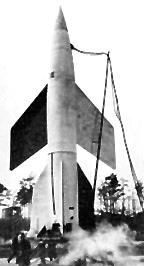 | A-4b launch Credit: Gary Webster |
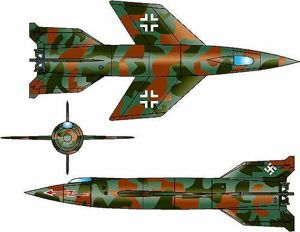 | A4b 3 view Credit: Gary Webster |
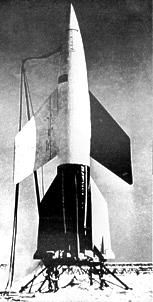 | A-4b Launch Credit: Gary Webster |
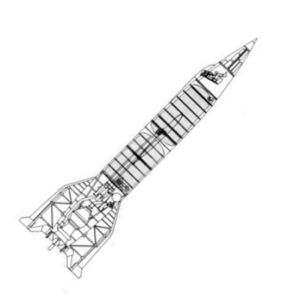 | A4b Cutaway Credit: Gary Webster |
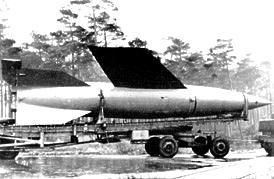 | A-4b in Meilerwagen Credit: Gary Webster |
November 1939 - . Launch Site: Peenemuende. Launch Complex: Peenemuende. LV Family: V-2. Launch Vehicle: A-4b, A9/A10.
- Peenemuende wind tunnel goes into operation. - .
Nation: Germany.
The tunnel was used an average of 500 hours per month. 1000 cubic metres of vacuum vessels were pumped to a 98% vacuum in three to five minutes by three banks of double vacuum pumps. When vented, they provided the tunnel with 20 seconds of run time at velocities from Mach 1.2 to Mach 4.0, or 1500 m/s. Models 4 to 5 cm in diameter x 30-40 cm long could be accommodated in the tunnel, instrumented at 110 data points. These tests showed that drag increased 70% at the sound barrier and that the centre of pressure on the missile moved back one-half calibre. The wind tunnel runs showed that the basic A4 shape was all right, but that it needed load-carrying wings and a new rudder for the higher-speed A9 glider version. Huge trial and error was required to develop an A9 configuration that was stable, but not so stable that the control surfaces were too large. An arrow wing was the best performing, but the control surfaces were then in the turbulent flow of the wing and inadequate. Swept wings provided 12% less glide ratio than the arrow wing, resulting in a 60 km loss of range. Trapezoidal wings were the final solution, the end of a long iterative process.
Peenemuende-developed delta wings were adapted to Army artillery rounds of the 105 mm flak gun and K5 280 mm cannon, decreasing drag by 35%. The result was an increase of 6 kg in the explosive load, a 6 kg increase in the iron mass of the round, but with a range increase from 59 to 90 km. Equipped with a new, lighter warhead, and a sabot boosting a slimmer round, the gun could shoot projectiles to a range of 135 to 150 km, with an accuracy of 2 per mill.
1944 October 24 - . LV Family: V-2. Launch Vehicle: A-4b.
- Construction of 5 prototype A4b winged V-2's completed - .
Nation: Germany.
The A-4b was a winged V-2. This resurrected work on the A-9, abandoned in 1943 to concentrate on V-2 production. The A9 was to be the second stage of an ICBM designed to reach North America. By this time in the war the intent was to extend the range of the V-2 once Allied forces pushed the German lines so far back that Britain could no longer be targeted.
1944 December 9 - . Launch Site: Peenemuende. Launch Complex: Peenemuende. LV Family: V-2. Launch Vehicle: A-4b.
- Pruefstand XII development started. - .
Nation: Germany.
The order was received in Peenemuende to begin serious development of Pruefstand XII, the project to launch V-2's from submerged capsules towed by submarine to launch positions off the US coast. Preliminary work was to be completed by the end of Marc. However there is no confirmed evidence that the prototype of the launch capsule was ever completed before Peenemuende was evacuated.
1944 December 27 - . Launch Site: Peenemuende. LV Family: V-2. Launch Vehicle: A-4b. FAILURE: Failure. Failed Stage: 1.
- A-4b #1 - .
Nation: Germany.
Agency: Wehrmacht.
Work on a winged version of the A4 had been stopped in early 1943. Now, with the Allies overrunning launch sites in Belgium and Holland, Kammler ordered it resumed in order to have a long-range version of the weapon that could reach England and Allied continental rear areas from Germany. Within weeks the wind tunnel results generated since 1940 were reviewed, and a prototype winged version of the missile built. On the first launch, the steering failed at 30 m, and the missile crashed a short distance from the pad. Several more test articles were on hand, but testing could not resume immediately due to a shortage of alcohol fuel.
1944 December 31 - . Launch Site: Peenemuende. Launch Complex: Peenemuende. LV Family: V-2. Launch Vehicle: A-4b, Taifun, Wasserfall.
- Peenemuende rocket team faces the New Year - .
Nation: Germany.
Related Persons: Hitler.
It was for them a depressing time. The V-2 came too late to affect the outcome of the war. The years 1939-1942, when Hitler had blocked development and production of the V-2, were lost years. By this time, the Peenemuende staff was allocated as follows: 135 were working on Taifun anti-aircraft barrage rocket; 1940 were working on the V-2; 1220 were working on the Wasserfall surface-to-air missile; 270 were working on the A4b winged V-2; and 660 were in administrative positions. Meanwhile Kammler was constantly underway, trying to deploy the wonder weapons he believed would save the Reich. He could only be met at one-hour meetings at autobahn intersections, on his way from one place to another.
1945 January 24 - . Launch Site: Peenemuende. Launch Complex: Peenemuende P10. LV Family: V-2. Launch Vehicle: A-4b.
- A-4b #2 - .
Nation: Germany.
Agency: Wehrmacht.
The first successful launch, this reached 80 km altitude and 1200 m/s. It then flew stably in supersonic flight using its 13.5 sq. m. wing. The automatic guidance system was designed to keep the missile on course in both supersonic and subsonic flight regimes. However the wing broke off shortly after the beginning of the glide. This concluded work on the A4b/A9; the increasingly chaotic situation in Germany prevented further flight tests.
Back to top of page
Home - Search - Browse - Alphabetic Index: 0- 1- 2- 3- 4- 5- 6- 7- 8- 9
A- B- C- D- E- F- G- H- I- J- K- L- M- N- O- P- Q- R- S- T- U- V- W- X- Y- Z
© 1997-2019 Mark Wade - Contact
© / Conditions for Use